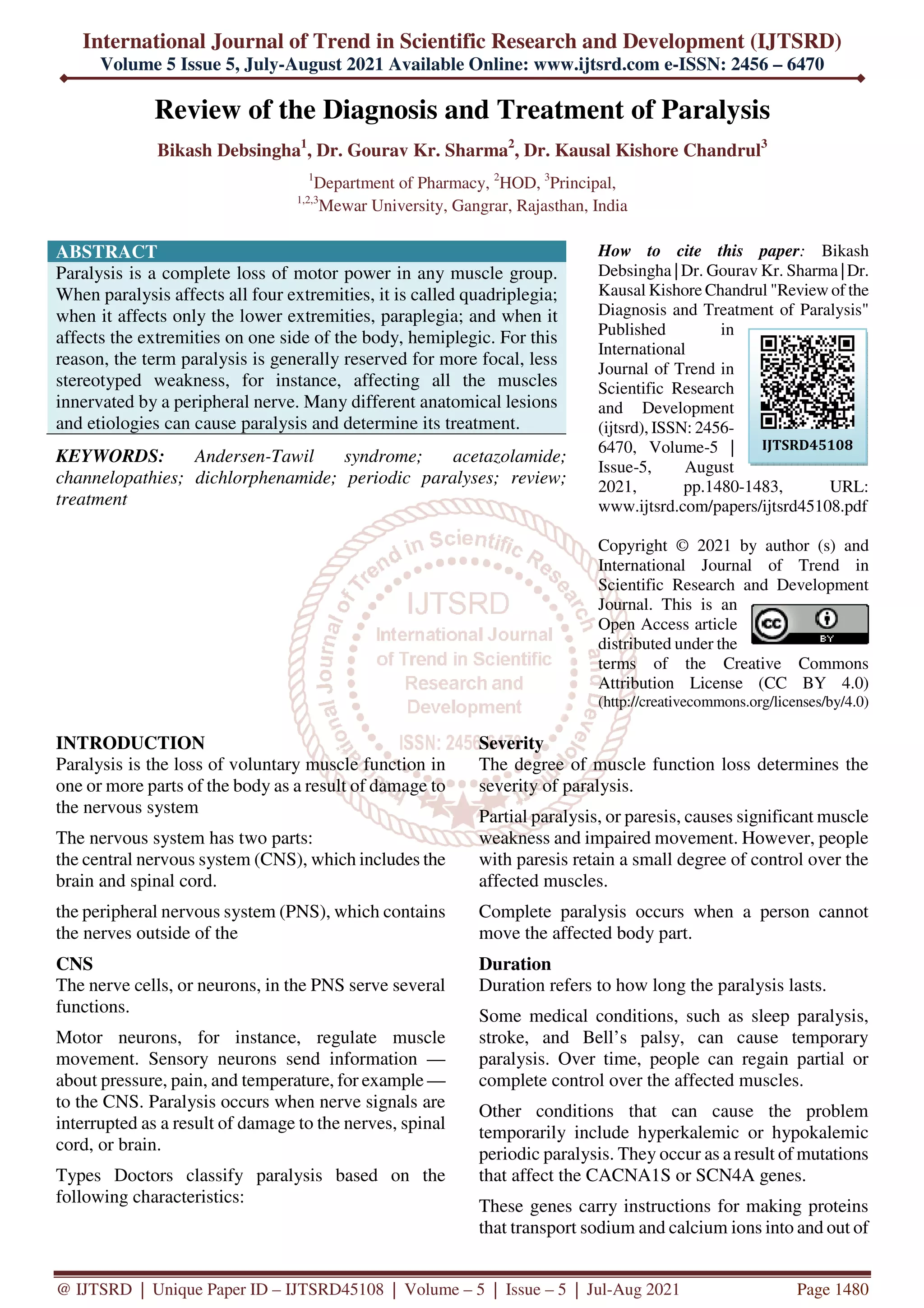The document reviews paralysis, describing it as the loss of motor power in muscle groups due to nervous system damage, and categorizes it into types such as monoplegia, hemiplegia, paraplegia, and quadriplegia. It discusses causes, effects, diagnosis, and current management strategies, highlighting that while paralysis might not be curable, rehabilitation can enhance quality of life. Additionally, it mentions various diagnostic tests needed to assess the severity and cause of paralysis.



![International Journal of Trend in Scientific Research and Development @ www.ijtsrd.com eISSN: 2456-6470
@ IJTSRD | Unique Paper ID – IJTSRD45108 | Volume – 5 | Issue – 5 | Jul-Aug 2021 Page 1483
X-ray: This test uses small amounts of radiation to
produce detailed images of the dense structures inside
the body, such as the bones.
CT scan: CT uses computers to combine many X-ray
images into cross-sectional views of the inside of the
body.
MRI: MRI uses a large magnet, radio waves, and a
computer to create clear images of the body.
Myelography: This test uses a contrast dye that is
injected into the spinal canal to make the nerves show
up very clearly on an X-ray, CT scan, or MRI.
Electromyography (EMG): This test is used to
measure the electrical activity in the muscles and
nerves.
Spinal tap: A long needle is injected into the spine to
collect spinal fluid.
MANAGEMENT AND TREATMENT
How is paralysis treated?
Currently, there is no cure for paralysis itself. In
certain cases, some or all muscle control and feeling
returns on its own or after treatment of the cause for
the paralysis. For example, spontaneous recovery
often occurs in cases of Bell’s palsy, a temporary
paralysis of the face. It might also occur to some
extent with treatment after a stroke. Sometimes,
treatment is important to prevent further worsening of
paralysis, for example in multiple sclerosis.
Rehabilitation is often recommended to address
problems that can occur as a consequence of the
paralysis, to enable the paralyzed person to live as
independently as possible and to provide the person
with a high quality of life. Some of the rehabilitation
treatments used for people with paralysis include:
Physical therapy uses treatments such as heat,
massage, and exercise to stimulate nerves and
muscles.
Occupational therapy concentrates on ways to
perform activities of daily living.
Mobility aids include manual and electric wheelchairs
and scooters.
Supportive devices include braces, canes, and
walkers.
Assistive technology such as voice-activated
computers, lighting systems, and telephones.
Adaptive equipment such as special eating utensils
and controls for driving a car.
Summery
Paralysis is the loss of muscle function in part of your
body. It happens when something goes wrong with
the way messages pass between your brain and
muscles. Paralysis can be complete or partial. It can
occur on one or both sides of your body
CONCLUSION
If you experience paralysis, you'll lose function in a
specific or widespread area of your body. Sometimes
a tingling or numbing sensation can occur before total
paralysis sets in. Paralysis will also make it difficult
or impossible to control muscles in the affected body
parts.
References ---
[1] https://www.google.com
[2] https://pubmed.ncbi.nlm.nih.gov/29125635/
[3] https://in.finance.yahoo.com/news/career-
paralysis-overcome-142016164.html
[4] https://my.clevelandclinic.org/health/diseases/1
5345-paralysis
[5] https://www.medicalnewstoday.com/
[6] https://www.spinalcord.com/types-of-paralysis](https://image.slidesharecdn.com/199reviewofthediagnosisandtreatmentofparalysisparalysis-210918052745/75/Review-of-the-Diagnosis-and-Treatment-of-Paralysis-4-2048.jpg)